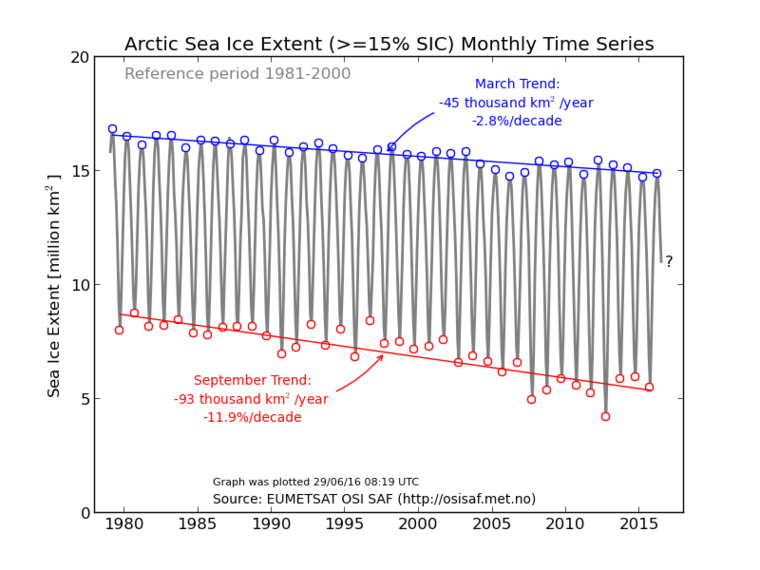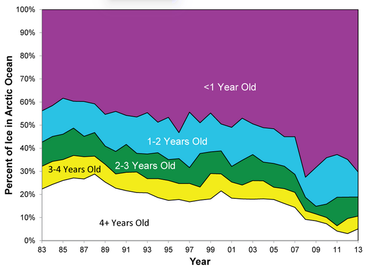Understanding the Arctic sea ice
Introduction
Sea ice is the layer of ice formed on top of the sea when it freezes. The sea ice in the Arctic covers almost all of the Arctic Ocean during winter. The extent is absolutely enormous: In the month of March, when the ice reaches its maximum extent, it covers approximately 16 million km2, seven times the area of Greenland.
When seawater freezes, the ice crystals growing to form the ice layer reject the salt from the ice, making the water below the ice much saltier. The difference in density between ice and water makes the ice float. The sea ice is highly dynamic. It moves around the Arctic Ocean, pushed and pulled by winds and currents. The extent of sea ice also shrinks and grows during the seasons. During the winter it grows to its maximum in March, and during the summer it diminishes. The sea ice minimum extent is reached in September, the extent is only about 1/3 of that in March.
Two measures for sea ice
The sea ice in the Arctic has reacted noticeably to the rise in air and ocean temperatures: There is significantly less sea ice now compared to 30 years ago.
Scientists use two basic measures for sea ice: extent and thickness.
Extent: Since 1979 it has been possible to monitor sea ice by satellite. We now have more than 30 years of reliable information on the extent of the sea ice cover.
The data shows that the extent in the summer is 30% smaller than it was at the beginning of the 1980s. The extent during winter has diminished by about 10%. In September 2012, the ice extent set a new minimum record: it was the smallest measured since 1979. Compared to the average extent (1979-2000), the sea ice had diminished by 49%.
Thickness: When assessing the state of sea ice, it is not always enough to look at the extent. The reason is that the extent covers areas with both very thin ice as well as areas with thick ice. To get a true picture of the state of the sea ice you should assess its volume, and here you have to take the ice thickness into account.
The thickness of the sea ice has also changed. Scientists use the terms first-year ice and multi-year ice. Multi-year ice does not melt away during summer and therefore it can grow to be as thick as 3 to 4 meters. However, the ice is now getting thinner, and the ice cover that forms during winter consists increasingly of first-year ice.
The records of sea ice thickness are not as precise and reliable as the information gathered on sea ice extent. The reason for this is primarily that it is difficult to obtain good data. DMI has developed a model, which can calculate the sea ice thickness using data from a weather forecast model from the European weather centre ECMWF (European Centre for Medium-Range Weather Forecasts).
Impact of the changes
The sheer size of the sea ice and the magnitude of the changes mean that effects will be – and already are – noticeable, in the Arctic and beyond. In the future, climate models indicate that we should expect even further melting of the sea ice. In the SWIPA-report from the Arctic Council, it is stated that we can expect a nearly ice-free summer within a few decades.
This has impacts in many areas:
Animals and plants: Many species of organisms live around the edges and in and under the sea ice. Nutrients and sunlight form the basis for the production of enormous amounts of algae and phytoplankton, which are the bottom level in the marine food chain in the Arctic. They are consumed by tiny crustaceans and other small animals that are food sources for shrimps, fish, whales, seals, etc. At the very top of the food chain, we find the top predators, polar bears and humans.
Exact predictions of the future of Arctic marine life are very hard to make.
However, scientists have already observed that animals that use the surface of the sea ice to hunt or rest (for example, polar bears and walruses) are having trouble. It is expected that the number of polar bears will drop, and they will start to look for new kinds of food in the future and new locations to search for food.
As summer sea ice diminishes, the algae gain access to much more sunlight, which means that more algae grow. It has been measured that the algae production in 2007 was 23% higher compared to the period 1998-2002.
Humans in the Arctic - challenges and opportunities: Central to understanding the conditions for human life in the Artic in the future is “accessibility”. For centuries the inhabitants in the Arctic have used the sea ice for transport, hunting and fishing. To some inhabitants, the accessibility to hunt, fish or simply move around will be worsened. In the areas, that have experienced less and thinner sea ice, transportation is more difficult and sometimes more dangerous.
On the other hand, accessibility to natural resources, such as minerals and oil and gas, and for shipping may improve in the future. As the sea ice diminishes, new opportunities thus appear on the horizon. For instance, the very old dream of passages for ships through the Arctic seems to be a realistic opportunity. The first commercial ships have already made the voyage from ports in Europe to ports in East Asia through the Arctic Ocean.
Global climate
The diminishing sea ice has the potential to further enhance global warming, change climate patterns and perhaps even influence global ocean circulation. It has been documented that the diminishing sea ice has created a feedback mechanism in the Arctic climate.
The sea is dark; the ice is white. That makes a big difference when it comes to reflecting sunlight. The dark sea absorbs heat while the ice reflects a much larger proportion of the sun’s energy (the “Albedo-effect”). So a smaller sea ice extent means more open, dark water, which results in more absorption of the sun’s energy in the seawater, and thus more warming of the seawater.
The warmer seawater raises the temperature of the air above, which means that ice formation will take place later in the year. And next year, when melting sets in, there is less ice and melting may happen faster, which means that the sea is open to absorb even more energy from the sun. And so on.
Scientists call it a positive feedback that enhances the changes even further. And this specific feedback has been documented in the Arctic. To what degree this will have effects outside the Arctic is still an open question.
The diminishing sea ice also has the potential to change global ocean circulation. In the Arctic Ocean, especially east of Greenland, a process takes place that is considered to be crucial for the circulation of the oceans. As the waters flowing north to this area cool, sea ice forms; leaving the water below the ice much saltier and denser. This heavier water sinks to the bottom and flows south along the deep plains of the Atlantic Ocean.
The force of this, in combination with similar processes in Antarctica, is so tremendous that these mechanisms actually fuel global ocean circulation. The cold water follows the bottom of the Atlantic, resurfaces, for instance, in the Indian Ocean and returns as a warm ocean surface current in the Atlantic Ocean, commonly known as “The Gulf Stream”. The system is often referred to as “The Great Conveyor Belt”.
To what extent “The Great Conveyor Belt” will be affected by the diminishing Arctic sea ice is still an open question.
For more information on sea ice see Links.







